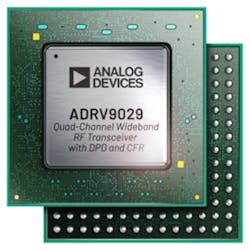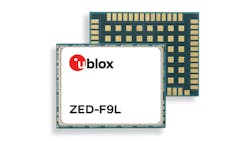Go Modular with RF to Shrink System Densities
This article is part of the TechXchanges: Internet of Things (IoT) and Defense Electronics.
Members can download this article in PDF format.
What you’ll learn:
- Drop-in subsystems enable miniaturizing of land-mobile radios and (satcom) equipment.
- Module packaging can vary widely between SiPs, SoCs, and SoMs.
- Module vendors are achieving astonishing feats of integration.
Communications systems play major roles in the progress of humanity, enabling almost instant sharing of important messages. Beyond its human users, communications systems of the future are expected to have even more electronic and machine users, connected via the internet. Internet of things (IoT) sensors will provide instantaneous data for monitoring the environment, homes, and offices. Robotic assistants on land, sea, and in the air will make many lives easier.
Communications are important for maintaining the functionality and performance of all these devices. Thus, adding communications capability of some kind will be an important part of the design and development of many new electronic system designs.
Fortunately, communications systems and subsystems are becoming smaller and more integrated. This makes it easier to include them in electronic designs that meet military and aerospace reduced (SWaP) guidelines and are cost-effective for commercial and industrial users.
Drop-In Subsystems
Fielding a communications system once called for an array of components, such as mixers, amplifiers, and oscillators, connected as receivers, transmitters, or transceivers. Now, most of the components are in a single device, such as a system-in-package (SiP) or system-on-chip (SoC) small enough to fit within a single multi-pin package.
These drop-in subsystems are enabling the miniaturization of land-mobile radios and satellite communications (satcom) equipment and providing radio links for automobiles and even unmanned aerial vehicles (UAVs) with the addition of just a few components.
Such chip-sized radios ease the integration of embedded communications into many electronic products and provide multiple forms of communications, including data sharing between electronic devices. In slightly larger sizes, integrated modules with two or more ICs, even antennas, will support the expansion of 5G wireless networks and user equipment.
SiPs vs. SoCs
The distinction between SiPs and SoCs isn’t always clear, although both are the end-results of efforts to miniaturize electronic products with greater numbers of functions. For higher-volume applications, when it’s helpful to drop a complete system solution onto a circuit board, a SoC provides all of the components needed for a system with a minimal number of interconnections, usually to closely spaced package pins.
A SiP may more resemble a subsystem, with several SiPs connected to form a complete system. SiPs are better suited for design and development stages of a product, when it may be necessary to understand how different subsystems operate together under different operating conditions.
A SiP usually consists of several integrated circuits (ICs) with supporting passive circuit elements within the same chip carrier package. One example is a BGA package that can perform multiple functions of an electronic system, such as computing and communications. A SiP may contain RF receivers, transmitters, transceivers, a central processing unit (CPU), and computer memory on the same substrate.
In contrast, a SoC is a full system, such as a receiver, transmitter, or transceiver, with microcontroller or microprocessor and central processing unit (CPU), memory, and memory interfaces, contained within a package. When size isn’t critical, larger solutions are available as system on modules (SoMs), with combinations of communications, computing, artificial intelligence (AI), digital signal processing (DSP), and even radar detection on a single printed circuit board (PCB).
A Look at SoCs and SiPs on the Market
For the level of integration possible, the ADRV9029 from Analog Devices is an SoC containing a frequency-agile transceiver for 75 to 6000 MHz in a 289-ball, chip-scale ball-grid-array (CSP_BGA) package measuring only 14 × 14 mm (Fig. 1). The compact housing holds four independently controlled transmitters and receivers, a pair of observation receivers for monitoring the transmitters, on-board frequency synthesizers, and DSP for a complete transceiver.
The ADRV9029 includes manual and automatic attenuation control and quadrature error correction (QEC), in the size of what was once a single device. But it’s a good fit for wireless communications in 3G, 4G, and 5G wireless networks and in base stations with multiple-in, multiple-out (MIMO) antenna configurations.
The company offers several evaluation kits with PCBs to help understand how to use SoCs in its RadioVerse line, and have them occupy less circuit-board area without thermal or electromagnetic (EM) repercussions. In a larger, 27- × 20-mm, 736-ball BGA housing, the model ADRV9040 is a transceiver SoC for 650 to 6000 MHz with eight differential transmitters and eight receivers (Fig. 2).
Analog Devices and Texas Instruments both developed strong assortments of SiPs in support of RF through millimeter-wave communications. While they may not provide the full functionality of an SoC, the SiPs integrate many necessary components and encourage high circuit density.
Analog Devices is paving the way to millimeter-wave (mmWave) communications in 5G wireless networks and other systems with a line of frequency converters in surface-mount-technology (SMT) packages operating as high as 86 GHz. For example, the ADMV7420 is a SiP in-phase/quadrature (I/Q) downconverter that translates signals from 81 to 86 GHz to an intermediate-frequency (IF) range of dc to 2 GHz.
The device is based on two function blocks: an input four-stage, GaAs low-noise amplifier (LNA) and a frequency downconverter. It consists of a GaAs in-phase/quadrature (I/Q) downconverter, on-chip buffer amplifier, and 6× frequency multiplier. The 6× multiplication is achieved with a cascade of 3× and 2× multipliers.
Most of the essential high-frequency components needed for downconversion of mmWave frequencies are packed into a 34-terminal, chip-array, small-outline, no-lead-cavity (LGA_CAV) housing measuring just 11 × 13 mm. The downconverter’s mixer provides differential I and Q signals suitable for direct conversion.
A companion frequency upconverter, ADI’s model ADMV7320, also relies on high-level integration to integrate numerous high-frequency components into a small package. It’s based on three function blocks: a frequency mixer and local-oscillator (LO) path; envelope detector, variable-gain amplifier (VGA), and power detector; and power amplifier (PA) and power detector. In a slightly larger 50-terminal, 16- × 14-mm LGA_CAV package, it achieves up to 33-dB conversion gain with minimum gain-control range of 40 dB. When set with 23.5-dB gain, it delivers +25-dBm typical output power.
Both frequency converters lack an on-board LO source, such as a frequency synthesizer, to form a full receiver or transmitter. They operate with a LO frequency range of 13.4 to 14.6 GHz but require additional LO. The ADMV7320 upconverter also has a built-in power detector and built-in envelope detector for LO nulling. Both are rated for operating temperature range of -40 to +70°C.
As important as the density that these devices bring to new communications equipment designs is the amount of evaluation they go through prior to final characterization. With proper interconnections to those multi-pin packages, users are assured of having a functional subsystem that will perform according to specifications, with a typical noise figure of 5 dB for both frequency converters.
Transceiver and Transmitter SiPs
Texas Instruments (TI), with one of the most agile and efficient websites in the industry, offers several RF SiPs with multiple transmitters and receivers for military and commercial radio applications. Model AFE7901 is a transceiver SiP that integrates a total of four RF sampling transmitter chains and four RF sampling receiver chains by means of eight digital-to-analog converters (DACs) and eight analog-to-digital converters (ADCs).
The AFE7901 operates from 5 MHz to 7.4 GHz in a flip-chip, ball-grid-array (FCBGA) package measuring 17 × 17 mm with 0.8-mm pitch. The DACs run at 12 Gsamples/s while the ADCs capture signals at 3 Gsamples/s.
With the aid of its digital upconverters (DUCs), the transceiver SiP can perform direct RF sampling at L-, S-, and C-band frequencies without frequency conversion, enabling light weight and miniaturization in portable radio systems. Digital step attenuators (DSAs) support amplitude tuning resolution of 0.125 dB over a 40-dB dynamic range for transmissions and 0.5 dB over a 25-dB dynamic range when receiving. The transmission bandwidth can be as wide as 400 MHz.
When even more bandwidth is needed, TI’s model AFE8000 provides eight transmitters and 10 receivers with a transmission frequency range of 5 MHz to 7.125 GHz and receive range from 100 MHz to 7.125 GHz.
The transmitter is capable of eight channels at 800-MHz bandwidth or four channels each with 1.2-GHz bandwidth. Meanwhile, the receiver can be set for eight channels each with 800-MHz bandwidth or eight channels with 400-MHz bandwidth and two channels each with 800-MHz bandwidth. This transceiver also uses 12-Gsample/s DACs and 4-Gsample/s ADCs and comes in several configurations with different channel counts, all in a 17- × 17-mm FC-BGA package.
With such capabilities packed into such a small, low-power device, it’s a good fit for radar and electronic-warfare (EW) systems as well as wireless communications in all markets. The SiP is scalable for various applications and provides fast switching speeds needed for time-division-duplex (TDD) communications systems.
For low-power radio applications, the models CC1110Fx and CC1111Fx are SoCs with MCUs, memory, USB controllers, and sub-1-GHz transceivers. Well-suited for automatic meter reading and low-power telemetry applications, these transceivers operate at the unlicensed bands at 315, 433, 868, and 933 MHz. The SoCs are supplied on a 36-lead chip carrier.
Automotive Modules
Mistral Solutions builds upon TI’s creativity, basing its board-level mmWave radar kits and modules on TI’s ICs. The 60- and 77-GHz automotive radar kits leverage the IWR6843 IC from TI to form complete frequency-modulated, continuous-wave (FMCW) radar modules available with two different antennas. Although large next to SiPs, they’re complete automotive radars contained within enclosures measuring 54 × 53 × 18 mm and weighing just 15 g, with three transmit and four receive channels.
Also targeted at automotive applications, u-blox offers a variety of IoT communications modules, including automotive navigation modules based on its model UBX-M8030-Kx-DR 3D ADR GNSS IC. The modules combine GNSS navigation data with individual wheel speed, gyroscope, and accelerometer data for reliable navigation even when a vehicle changes speed.
For example, model ZED-F9L is an L1 (1575.42 MHz) and L5 (1176 MHz) dual-frequency GNSS receiver module (Fig. 3) with 50-Hz update rate for low-latency navigation, telematics control unit (TCU), and vehicle-to-everything (V2X) communications applications. It helps drivers find a location even when satellite navigation signals are obstructed, such as through tunnels and indoor parking garages.
The three-dimensional automotive dead reckoning (3D ADR) provided by the module complements automotive navigation based on GPS and GNSS satellite navigation systems. It also contains antijamming and anti-spoofing hardware and software. In addition to the navigation modules, u-blox also developed standalone wireless IoT modules with three radios in each: Wi-Fi 6, Bluetooth LE, and Thread.
WLAN, Wi-Fi, and FEM SoCs
Broadcom has simplified the addition of IEEE 802.11 wireless local-area networking (WLAN) capability to electronic products with the development of WLAN SoCs based on its BCM4778 dual-frequency L1L5 GNSS receiver. The SoC receiver is designed to provide WLAN interconnections at low power levels with jamming protection and a full range of in-band and out-of-band filtering. By employing the company’s Grid Tracking technology, it maintains wireless connections between parties even in settings with large numbers of users, such as densely populated urban environments.
Rather than a complete system, many SoCs provide key parts of the system, such as transmit/receive (T/R) front-end modules (FEMs) from Qorvo with both low-noise amplifiers (LNAs) and power amplifiers (PAs) in the package. Based on GaN semiconductor technology for the PAs and GaAs for the LNAs, the FEMs supply as much as 10-W output power from a 7- × 5-mm LGA housing.
The QPF5010 is the high-power member of the family, with 10-W output power from 8 to 12 GHz and power-added efficiency of 30% to 40%. Although in such small housings, they incorporate four blocks—a T/R switch, PA, LNA, and limiter.
Such FEMs ease the task of maintaining signal power in 5G or satcom infrastructure equipment, since the PAs and LNAs can be mounted physically close to the antennas to provide increased gain and power for transmission and reception, respectively.
MACOM Technology Solutions developed its model MAMF011099 5G antenna beamforming FEM to enhance Ka-band transmit and receive operations from 24.25 to 29.00 GHz. The module features three MMICs, which include a LNA, PA, directional coupler, and switch driver, to serve the signal path between a base station and antenna, all in a lead-free, 40-lead, 6.5- × 6.5-mm AQFN package. Both the PA and LNA are powered by +5 V dc.
Quectel Wireless Solutions, supplier of antennas and transceiver modules that are meant to boost signals from 4G/5G antennas, offers the FGH100M Wi-Fi HaLow module. It’s for the sub-1-GHz version of Wi-Fi (IEEE 802.11ah) meant to provide much greater wireless communications range than traditional Wi-Fi radios for smart cities, smart buildings, and smart warehouses. It operates in the 850- to 950-MHz band with +21-dBm maximum output power and 32.5-Mb/s maximum transmission speed.
To help with wireless data flow around offices and homes, MaxLinear developed a line of Wi-Fi SoCs certified to Wi-Fi 6 and Wi-Fi 6E standards and housed in LFBGA packages measuring 12 × 17 mm. The SoCs can handle as many as four streams of 6-GHz data simultaneously.
Based on the company’s WAV600 Series-2 Wi-Fi chipset, which operates to 4.8 Gb/s with higher-order modulation such as 1024 quadrature amplitude modulation (QAM), the SoCs can support as many as 256 users simultaneously such as in a crowded office environment. The firm’s AnyWAN broadband Wi-Fi SoCs are designed to provide wireless-area-network (WAN) service to hard-to-reach places.
Monitoring SoM
Qualcomm has applied its talents for integration to a line of robotics control and monitoring SoMs. The QRB2210 contains key analog and digital components for robotic control and monitoring under the roof of a single multipin package.
Well-suited for use in social assistants, education robots, at-home automated assistants, and surveillance systems, it’s centered around a 64-bit Arm Cortex microprocessor capable of clock speeds to 2 GHz. It includes a DSP that’s shared between the sensor core and audio subsystem as well as 720- × 1680-pixel display support. The SoM includes Wi-Fi and Bluetooth connectivity for wireless remote control and communications.
SiP Service
For those seeking to develop custom SiPs, Teledyne e2v Semiconductors performs SiP packaging as a service. The company follows a customer’s design requirements and, working with electrical and thermal simulations, they analyze the effects of different circuit layouts and density. Assembly is performed according to an agreed-upon strategy, followed by testing and product qualification.
All packaging assembly, testing, and screening is done according to industry standards, without issues from dealing with different component and material suppliers. In support of its SiP assistance, Teledyne e2v Semiconductors boasts AS9100 aerospace quality certification, multiple-zone baking ovens, and a Class 100 clean room.
Read more articles in the TechXchanges: Internet of Things (IoT) and Defense Electronics.
About the Author
Jack Browne
Technical Contributor
Jack Browne, Technical Contributor, has worked in technical publishing for over 30 years. He managed the content and production of three technical journals while at the American Institute of Physics, including Medical Physics and the Journal of Vacuum Science & Technology. He has been a Publisher and Editor for Penton Media, started the firm’s Wireless Symposium & Exhibition trade show in 1993, and currently serves as Technical Contributor for that company's Microwaves & RF magazine. Browne, who holds a BS in Mathematics from City College of New York and BA degrees in English and Philosophy from Fordham University, is a member of the IEEE.



